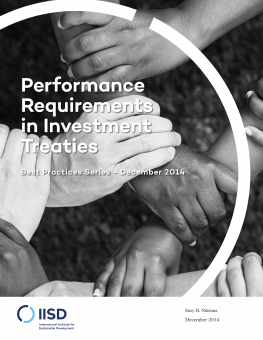
IISD Best Practices Series: Performance Requirements in Investment Treaties
This paper surveys the types of performance requirements (PRs) in use around the world, and briefly describes the WTO’s Agreement on Trade-Related Investment Measures (TRIMs).
This paper surveys the types of performance requirements (PRs) in use around the world, and briefly describes the WTO’s Agreement on Trade-Related Investment Measures (TRIMs).
The study focuses on the meaning and scope of PR-related clauses in bilateral investment treaties (BITs) and the interpretation of such clauses by investment tribunals.
If well formulated and applied, PRs can be effective tools to maximize the economic, environmental and social benefits of foreign investments. Therefore, it is important for states, particularly developing countries, to retain the possibility of using them when circumstances warrant it.
In this context, the growing trend of prohibiting most PRs in some investment treaties, combined with the investor–state dispute settlement mechanism, seriously impairs the ability of developing states to use these development policy tools. Notably, these restrictions and prohibitions on PRs often go beyond WTO TRIMs prohibitions— and, when available, exceptions in BITs are not always effective before tribunals.
Finally, the paper provides some options to help states preserve their policy space in BITs for imposing, if needed, PRs on foreign direct investment (FDI) in their territory.
Participating experts
Additional downloads
You might also be interested in
IISD Best Practices Series: The Most-Favoured-Nation Clause in Investment Treaties
This IISD Best Practices paper studies the most-favoured-nation (MFN) clause in investment treaties and its interpretation by arbitral tribunals, drawing lessons for states.
IISD Best Practices Series: Exhaustion of Local Remedies in International Investment Law
Part of IISD’s Best Practices Series, this advisory bulletin reviews state-of-the-art options and approaches to the exhaustion of local remedies requirement in international investment law.
IISD Best Practices Series: State-State Dispute Settlement Clause in Investment Treaties
This paper looks at state–state dispute settlement provisions in international investment agreements, examining the different mechanisms used to settle investment disputes, including judicial, quasi-judicial and arbitration procedures.
IISD Best Practices: Compensation for Expropriation
This paper analyzes the principles governing compensation for expropriation, as well as the primary methods of calculating the amount.